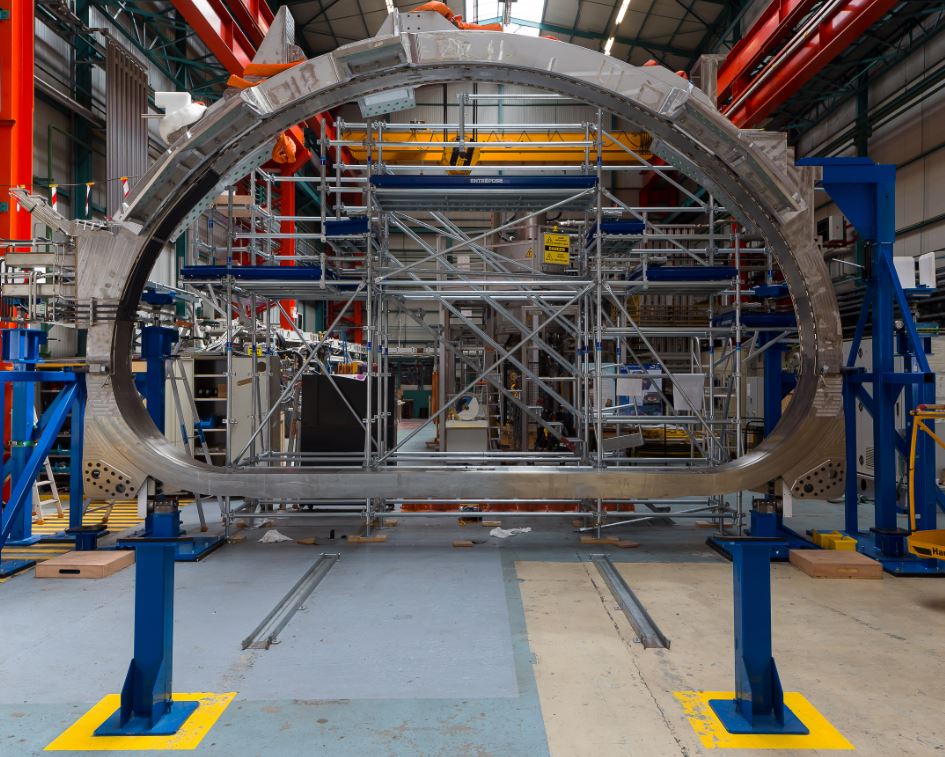On 16 January 2018, the tenth - and last - toroidal field coil for JT-60SA, produced by the GE [1] Power (formerly Alstom) workshops in Belfort and built under the CEA's responsibility, successfully passed the final acceptance tests. Ten additional coils are being built in Italy by ASG[2], under the responsibility of the research organisation ENEA[3]. The JT-60SA reactor will only use 18 coils; two additional (Italian) coils are being built mainly to ensure supply planning and cover any potential setbacks.
All of the 20 European superconducting coils built for the JT-60SA Japanese reactor have been the subject of tests in the dedicated cryogenic test station located at the CEA research centre in Saclay (Essonne). These tests have enabled these 7.5m high, 4.5m wide and 45cm thick big, electromagnetic superconducting coils to be qualified under their nominal conditions with regard to operating temperature (4.5K; -268.5°C) and current (25.7kA).
All of the coils fulfilled the required criteria andunderwunderwent a quench test[4], enabling their operating temperature margin - whose correct functioning forms the basis of the future successes of the JT-60SA tokamak - to be determined.
The final two coils, after each having been fitted with their external link structure - the assembly of which requires submillimetric accuracy - have been securely placed in their transport packaging. The mass of the two packages is close to 31 tonnes (16 for the coil, five for the external structure and 10 for the packaging structure). In mid-February the two coils fitted in this way will be flown to Naka on a specially chartered Antonov 124 cargo aircraft where they will be reunited with their 16 older sisters within the Japanese tokamak structure.
For all of these coils, it is therefore a technical and human adventure of more than 10 years that will draw to a close over the coming days. It has included many stages since the definition of specifications, design, contracting strategy, qualification and validation of the manufacturing processes and the implementation of strict quality control prior to the launch of the first productions in December 2013.
The commissioning of JT-60SA is scheduled for the summer of 2020. It will then become the largest tokamak in operation in the world until the launch of ITER. Its operation is already eagerly awaited by the international scientific community.

The JT-60SA reactor during assembly in Naka in Japan. © CEA
1] ITER, for 'International Thermonuclear Experimental Reactor' - and 'the way' in Latin - is an international civil nuclear fusion research reactor project currently built at Cadarache (Bouches-du-Rhône), in France.
[2] General Electric.
[3] ASG Superconductors.
[4] Agenzia nazionale per le nuove tecnologie, l'energia e lo sviluppo economico sostenibile (Italian National Agency for New Technologies, Energy and Sustainable Economic Development)
[5] The 'quench' risk corresponds to the incidental return of the magnet from a superconducting state to a resistive state. During such an event, the energy stored in the magnet will be dissipated in an external resistor in order to minimise the increase in temperature in the magnet and the mechanical constraints that may appear.
[6] Also installed and put into operation in Japan under the CEA's responsibility.
[7] Installed and put into operation in Naka by the teams from the CEA and the designer and manufacturer Air Liquide, world leader in gas, technologies and services for industry and health.
A Broader Approach towards the industrial use of fusion
In 2007, in support of the international R&D roadmap on fusion - which notably passes via the ITER project - the European Atomic Energy Community (Euratom) and the Japanese government signed an agreement called 'Broader Approach', defining a joint research and development programme. The objectives of the Broader Approach are to prepare the operation of ITER, broaden its research programme and develop R&D in order to size an economically attractive prototype power reactor: DEMO.
Within the scope of this Broader Approach, France has committed to providing Japan and its new tokamak with a wide range of cutting-edge equipment:
the cryogenic factory
[2] aimed at cooling them down to extremely low temperatures has also been supplied
[1] Also installed and put into operation in Japan under the CEA's responsibility.
[2] Installed and put into operation in Naka by the teams from the CEA and the designer and manufacturer Air Liquide, world leader in gas, technologies and services for industry and health.